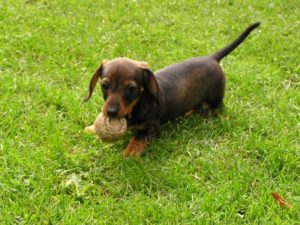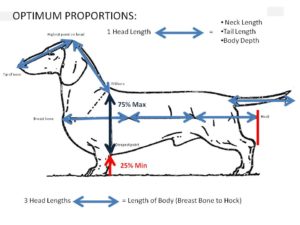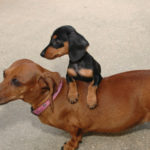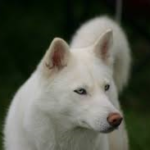Introduction
In the late 19th century, German hunters needed smaller Dachshunds to be used on European hare, which usually occupied narrower burrows compared with foxes and badgers.
As a result of time-consuming pedigree breeding, a Miniature Dachshund was created – a small, but strong dog with a lively character.
Size
In the USA, Great Britain and most English speaking countries there is one size for a Miniature Dachshund. In Germany (a Dachshund’s homeland) there are two sizes for this breed: miniature and rabbit Dachshunds. The two sizes are differentiated by chest circumference rather than weight, moreover, rabbit Dachshunds are smaller than their miniature relatives.
The average size of a Miniature Dachshund is 16-21 cm at the shoulder (male) and 14-19 cm (female). However, a Miniature Dachshund is not far from its standard relative, whose average size at the shoulder is about 20-27 cm.
Average Weight
By weight, a Miniature Dachshund is 2 times smaller than its standard relatives: average weight of a male Miniature Dachshund is 5 kilos, of a female Miniature Dachshund – 4 kilos (in comparison, a standard Dachshund weights about 9 kilos).
Actually, Miniature Dachshund puppies experience their most rapid puppy growth rate between birth and 11 weeks of age. After that it slows down considerably, usually ending at somewhere between 8 and 12 months when the puppy becomes a mature adult.
Weight Chart
For the sake of convenience, we are going to provide you with weight chart for a puppy of Miniature Dachshund. Remember, that this weight data is approximate:
- 1 month – a puppy should weight under 1 kilo;
- 3 months – 1 kilo;
- 4 months – 1,5 – 2 kilos;
- 6 months – 2-3 kilos;
- 8 months – 3-4 kilos (the weight of an adult Miniature Dachshund).
Obesity
Excessive weight may be connected with hormonal shift, inappropriate diet or low physical activity, which is why it is necessary to take care of a Dachshund concerning its diet and physical exercises.
The Dachshund’s body should be lean and muscular with a pronounced arch behind the ribs. The Dachshund’s chest bone should visibly protrude, with a dimple on each side.
If you notice that the fat around the chest covers the breastbone, or that the dog displays a rounded waistline that does not arch upward at the abdomen, your Dachshund has some extra weight. This is true for both miniature and standard Dachshunds.
If your dog has an ideal weight, you should be able to feel the ribs without probing through fat.













